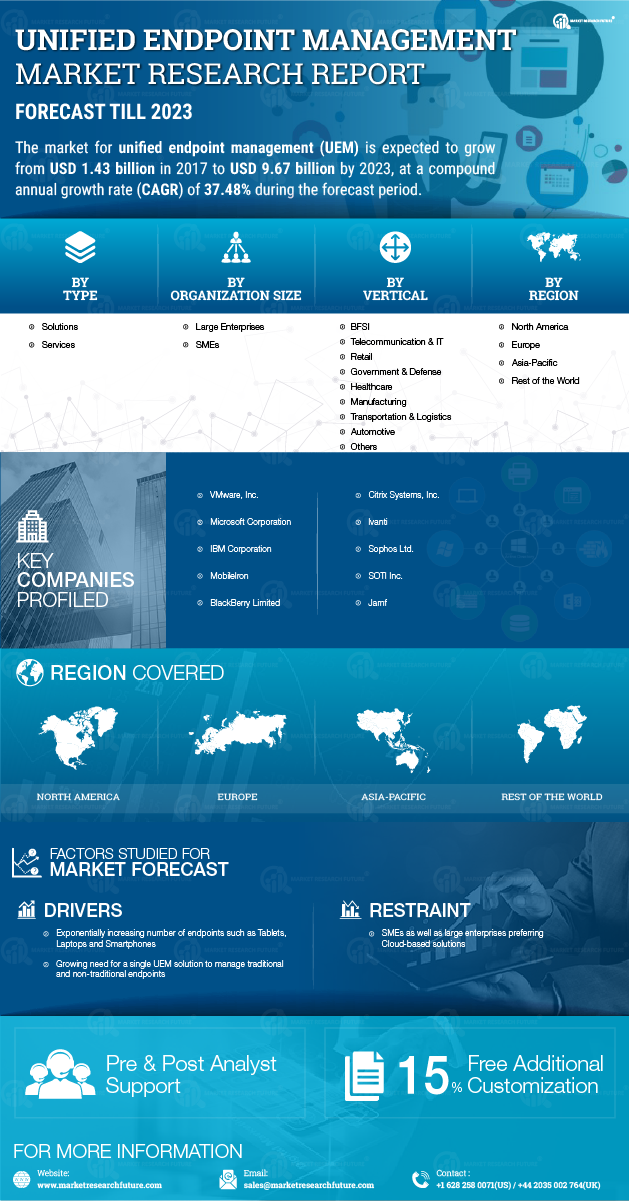Emergence of IoT Devices
The rapid emergence of Internet of Things (IoT) devices is significantly influencing the Unified Endpoint Management Market. As organizations integrate IoT devices into their operations, the complexity of managing these endpoints increases. Recent estimates indicate that there will be over 30 billion connected IoT devices by 2025, necessitating sophisticated management solutions. Unified Endpoint Management Market systems are essential for ensuring the security and functionality of these devices, providing centralized control and monitoring capabilities. As the adoption of IoT technology continues to expand, the demand for effective endpoint management solutions is likely to grow, thereby propelling the Unified Endpoint Management Market.
Growing Cybersecurity Threats
The escalating frequency and sophistication of cyber threats have underscored the necessity for comprehensive security measures within the Unified Endpoint Management Market. Organizations are increasingly recognizing the importance of safeguarding sensitive data across all endpoints. Recent statistics indicate that cyberattacks have surged by over 50% in the past year, prompting businesses to invest in advanced security solutions. Unified Endpoint Management Market systems offer integrated security features, such as threat detection and response capabilities, which are essential for mitigating risks. As the threat landscape evolves, the demand for robust endpoint management solutions that prioritize security is expected to grow, thereby propelling the Unified Endpoint Management Market.
Regulatory Compliance Requirements
The imposition of stringent regulatory compliance requirements across various sectors is driving the demand for Unified Endpoint Management Market solutions. Organizations are increasingly required to adhere to regulations such as GDPR and HIPAA, which mandate the protection of sensitive data. Failure to comply with these regulations can result in substantial fines and reputational damage. Unified Endpoint Management Market solutions facilitate compliance by providing tools for data encryption, access control, and audit trails. As businesses strive to meet these regulatory demands, the adoption of endpoint management solutions is likely to increase, thereby enhancing the growth trajectory of the Unified Endpoint Management Market.
Shift Towards Cloud-Based Solutions
The transition towards cloud-based solutions is reshaping the landscape of the Unified Endpoint Management Market. Organizations are increasingly migrating their operations to the cloud to leverage scalability, flexibility, and cost-effectiveness. Recent data suggests that the cloud services market is expected to grow at a CAGR of 22% over the next five years. Unified Endpoint Management Market solutions that are cloud-based offer enhanced accessibility and real-time updates, which are crucial for managing diverse endpoints effectively. As more businesses adopt cloud technologies, the demand for cloud-compatible endpoint management solutions is anticipated to rise, further fueling the growth of the Unified Endpoint Management Market.
Increased Adoption of Mobile Devices
The proliferation of mobile devices in the workplace has catalyzed the growth of the Unified Endpoint Management Market. Organizations are increasingly adopting mobile devices to enhance productivity and flexibility. According to recent data, the number of mobile devices used in enterprises is projected to reach 5 billion by 2025. This surge necessitates robust management solutions to ensure security and compliance across various platforms. Unified Endpoint Management Market solutions provide a centralized approach to manage these devices, enabling IT departments to streamline operations and reduce costs. As businesses continue to embrace mobile technology, the demand for effective management solutions is likely to escalate, further driving the Unified Endpoint Management Market.


















Leave a Comment